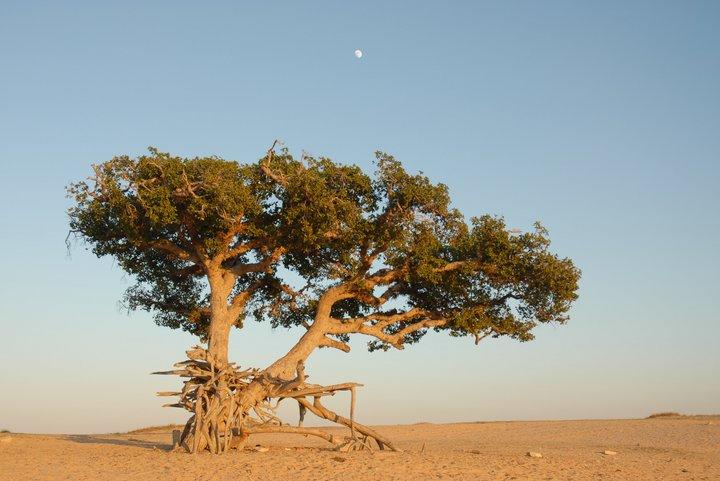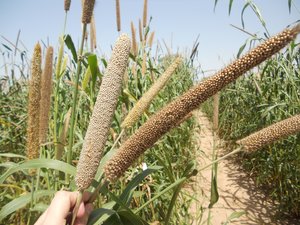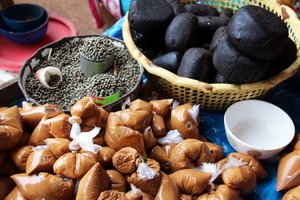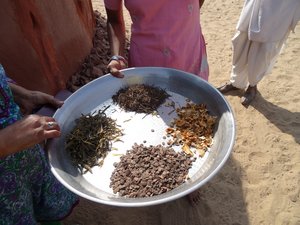Assessing the importance of agricultural and tree biodiversity in dryland production systems

Bioversity International and partners are investigating what biodiversity is used and valued by rural households for food and agriculture in three dryland regions. Mauricio Bellon, Principal Scientist, explains why and how in a recent interview.
Bioversity International and partners are investigating what biodiversity is used and valued by rural households for food and agriculture in three dryland regions – W.Africa & the Sahel, Eastern and Southern Africa and South Asia.
This research is being carried out as part of the CGIAR Research Program on Dryland Systems.

Mauricio Bellon, Principal Scientist, Bioversity International (pictured right) explains why and how in a recent interview.
Q: This work is being carried out in dryland agricultural production systems. What is a dryland agricultural production system?
A: More than 40% of the world’s surface is classed as a dry area, and around a third of populations living in dry lands, depend on agriculture for food security and livelihoods, many living in chronic poverty.
The term ‘dry land’ actually refers to many different kinds of varied and diverse systems but it is basically areas where water is difficult to access and in many cases where rainfall is less than 250 ml a year. To put this into perspective, it is equivalent to a medium sized- glass of water a year, so not much! This makes it challenging for these populations to produce enough food to eat and sell due to lack of rain and limited access to other sources of water for agricultural and consumption needs, severe drought periods, extreme weather events and land degradation, such as desertification. These severe climatic conditions are real challenges for the local plant and animal biological diversity present in the areas.
For example, many of the people we work with in north western India have no access to irrigation. They have access to groundwater but it is high in fluoride and so not suitable for drinking, which means they rely on capturing all the water from rainfall to drink.
Q: Why is understanding the uses of biodiversity for agriculture important in dry areas?
A: As conditions become even more challenging, with the effects of climate change, we know that these rural communities are already using diversity as a tool for agricultural production.
 What is continually surprising to see is how much diversity is being used and for many different purposes, even with such little rainfall. In just one research site, in Jodhpur, India, we counted around 18 different annual crop species and 17 tree species. The trees are important as they have deep roots so can access water far below the ground. Having a diversity of crops, means you can plant different ones at different times that have different seasons and different resistance to crop pests and diseases – in this way the communities can manage risk of losing all their harvests in a much more effective and flexible way.
What is continually surprising to see is how much diversity is being used and for many different purposes, even with such little rainfall. In just one research site, in Jodhpur, India, we counted around 18 different annual crop species and 17 tree species. The trees are important as they have deep roots so can access water far below the ground. Having a diversity of crops, means you can plant different ones at different times that have different seasons and different resistance to crop pests and diseases – in this way the communities can manage risk of losing all their harvests in a much more effective and flexible way.
Q: What kind of agricultural and tree biodiversity are we assessing?
A: We are looking at species that are relevant for food and agriculture that are being used by rural households in the regions where we are working. We are mainly working on plants—both annual and perennial species—and also on some domesticated animal species, and even fish or hunted wild animals in some cases. We are looking at major crops like maize and cassava, but we are also asking what else is used and for what purpose. This means looking beyond the major crops to wild, semi-wild and perennial species in our study.
Q: How are we carrying out this assessment?
To get to the heart of assessing just which biodiversity is being used for what purpose, you have to work closely with the communities to get individual knowledge and then work with the communities to build a common consensus that brings together all the knowledge, so we can work with them in a holistic way to find appropriate ways to improve the resilience of their farming systems.
To achieve this, we have adopted several methods. First we started with focus group discussions ensuring that we had a wide representation of community members: men and women; farmers and household members; different ages; etc. We asked the group what they grew and also to classify what they grew in one of four ways:
- What many people grow that collectively cover a large area of land
- What many people grow but that collectively represents a small area
- What is grown by just a few people but that still cover a large area of land
- What is grown by just a few people that collectively covers just a small area of land.
This approach has been developed by Bioversity International to help assess agricultural and tree biodiversity, and even if entirely subjective, it allows us to understand the prevalence of species both in terms of area and the number of farmers and households that grow them.
We also investigated the different uses of this diversity. For example do men and women use the diversity differently – perhaps the women may focus more on food for the household while the men focus more on income opportunities at the market? We also look at which parts of the species are used, for example, with a plant, is it the leaves, the stems, the fruits, or all of these.
In addition, we examined which people have access to seed or planting material as well as food – are they growing it, buying it, getting it from the wild, borrowing it from neighbours, or from food aid interventions.
 The really important part of this approach is to then take the data and look collectively at what is in the whole system and how it is being used – taking a ‘systems approach to propose alternative options to benefit the farmers.
The really important part of this approach is to then take the data and look collectively at what is in the whole system and how it is being used – taking a ‘systems approach to propose alternative options to benefit the farmers.
For example, we found out that in Rajasthan, that farmers considered that groundnuts were really important for income. Yet we found hardly any farmers grow them. The easy answer then is to say, well grow more groundnuts. But you also need to understand the context – if they grow more groundnuts, what will they grow less of, and what is the impact of this, for example, on nutrition. Is there really a market? Is there a reliable and affordable seed supply? A whole set of tradeoffs need to be considered with whatever you propose to change the system.
Q: What are some of the challenges of this approach?
A: Working closely with communities is vital to understanding more about their relationship with their local agricultural biodiversity, but it does require relying on more qualitative data, as farmer knowledge and community consensus plays an important part of data gathering. It is a ‘snapshot in time’, but a very detailed one.
We also have to work around local languages – across communities, words for things may be different, especially when it comes to local cuisine. We are also finding many uncommon species of plants, and in some cases, very rare species. This requires us to send photos to taxonomists so we can identify them.
Q. Could you give an example of how this approach has been used by others?
A: The Malawi Plant Genetic Resources Centre at Chitedze Research Station, part of Malawi’s Department of Agricultural Research (DARS), collaborated with us in the implementation of the assessment there. They found the approach and methodologies useful and used them in 2015 to assess the crop diversity present in the Mzuzu District, a drought-prone area where the population relies heavily on food aid, to identify local crops and varieties in order to provide them with a diversity of seeds that are well-adapted to their conditions and to help improve the reliability of local food production, thus lessening their dependence on outside food aid.
 Q: What are some surprising findings so far?
Q: What are some surprising findings so far?
One of the most interesting findings to me has been how rural communities use trees. For example in Rajasthan in India, we had thought that trees would be very important for fuel or fodder, but what we found was that the most important use in many tree species is for human nutrition. For example, many of these are leguminous plants, and they use their pods in local food dishes. This not only brings nutrition to the plate, but also taste, as I can testify having been lucky enough to try it.
So while they are not actively planting the trees, they are maintaining them in their fields rather than cutting them down, ensuring they are safeguarded for future use.
Another interesting finding is the genius research spirit of farmers, especially women farmers, in selecting and domesticating wild vegetables. Farmers in Niger in West Africa observe and select wild plant species that they think can be used for food or feed in the lean period. The selected plants are grown in small plots and tested on animals. From this trial, some are selected to be tested in very small quantities eaten by the community leader. If all goes well and there are no negative effects, the plant is then produced on larger plots and proposed as a food to more household members. Several of such species and varieties (Senna tora, Ceratotheca sesamoides, Dioscorea sp etc.) are today grown and sold in markets.
For more information, please contact Mauricio Bellon
This work is carried out through Bioversity International's Productive and Resilient Farms, Forests and Landscapes Initiative. It is also contributes to the CGIAR Research Program on Dryland Systems. Dryland systems operates in 5 regions – West Africa & the Sahel, East & S Africa and South Asia including India and Pakistan, in Central Asia and North & West Asia – with Bioversity International leading the agricultural biodiversity assessments in W.Africa & the Sahel (Mali and Ghana), in Eastern and Southern Africa (Malawi) and in South Asia (India).
Photos:
Top: Ficus sycomorus, a desert tree widely distributed in Africa and parts of Asia. Credit:Bioversity Internationa/R. Khalil
Second: Pearl millet field in Jodhpur, India. Credit Bioversity International/C.Bonham
Third: Groundnut paste and néré (black) for sale in market, Ghana. Neré is a local seasoning paste made from a wild tree Parkia Biglobosa, usually by women. Credit: Bioversity International/C.Zanzanaini
Bottom: A selection of forest foods used within a dryland agricultural production system, India. Credit: Bioversity International/P. Mathur
